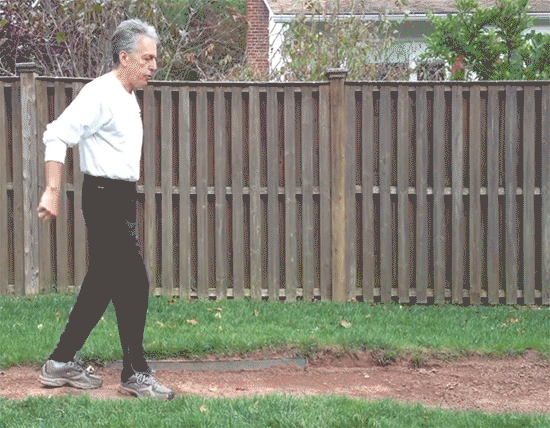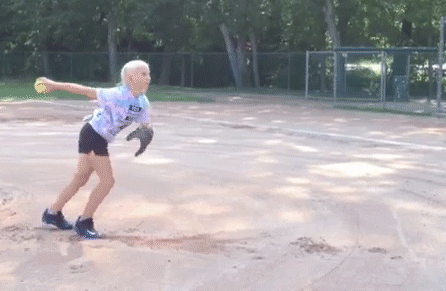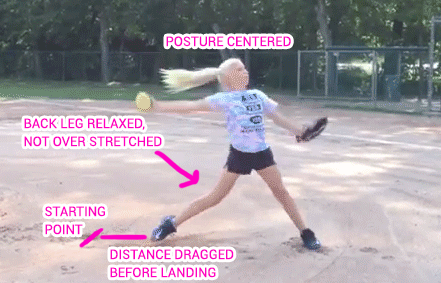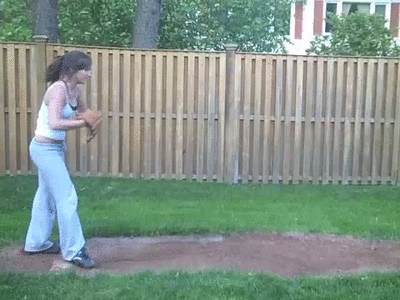How to Stride Farther
This is a long overdue request from reader Raquel, who is having trouble finding a pitching coach for her 9-year-old daughter and is ready to push her to the next level.
New beginners, with good reason, typically start by taking a simple, easy-to-manage walking step off the pitching rubber, as opposed to the aggressive leap you see from advanced pitchers. So naturally, one of the first things every one thinks about when leveling up a little bit is increasing stride length. There are a number of drills you can use to accomplish this, but first it’s important to understand where stride length comes from and how much is too much.
Where does stride length come from?
If you’re trying to increase your stride by stretching your stride leg farther away from you, it’s time to rethink your approach!
One of the most important factors in pitching with good speed and command without compromising safety is good, natural, relaxed posture. Stand with your feet a bit wider than your hips, creating a solid athletic foundation with the weight on the balls of your feet, like you’re getting ready to hit a punching bag, about to bend down to field a grounder, guarding someone in basketball, or waiting for a tennis serve. Now stand with your feet as wide apart as possible and ask yourself these questions:
- Which position is more comfortable? Does one hurt?
- Which position makes you feel ready to move? Allows you to put your weight on the balls of your feet?
- Which position would make it easier for someone to knock you over?
- Which position makes you feel more powerful and in control?
You probably know the answer without even trying for yourself… having your feet only a little more than hip width apart gives you greater posture, stability, and athleticism. This is true in pitching too. In addition to the problems listed above, if you add forward movement to a really big leg stretch, you’ll probably end up leaning forward with your upper body too.
While you do want to get the feeling of an aggressive but manageable stretch in your leg when you’re striding, you’ll want to land with your feet a comfortable distance apart. So how do you do this AND still get your stride longer?
By pushing harder off the rubber! You must propel yourself further forward using the energy in your push leg. What does this look like?

Here’s Coach Phil demonstrating part of the pitch slowly, but this is also an excellent example of how beginners are taught to stride at the very beginning. Notice how he lands with his feet a very comfortable distance apart, and his push foot pivots but does not otherwise move before he lands. From here he would drive through to the front.

This is one of our students at about age 12. Like Coach Phil in the example above, she lands with her feet a comfortable distance apart, but her push foot glides along the ground some distance before her stride foot touches down:

This is probably about 8-10 inches of pre-landing drive, which is a GREAT goal that this student was able to achieve at an unusually young age. When you’re transitioning from Coach Phil’s example to this example, you want to start with about 2 inches, and gradually increase that as you get the hang of it. Eventually, if you want to be a D1 recruit, you can go this far:

That’s more than a foot of pre-landing drag! But notice how her feet are still comfortably close together at landing and her posture is good.
It’s EXTREMELY IMPORTANT that you work toward this gradually so that your drive foot stays on the ground and you don’t start illegally hopping.
Here is a simple explanation of how this works:
How far is too far?
The optimal stride length is different for everyone. It depends on your height, body type, etc. And it is DEFINITELY possible to stride too far. Technically, the farther you can get off the rubber the better, but this is ONLY true if it does NOT COMPROMISE your posture. If it does, the detriment from bad posture is greater than the benefit of the long stride. Read this for more information.
Drills and information for increasing stride length
These are really drills for increasing push off the rubber, and getting the feel for the stride and glide movement rather than having a stationary back foot.
Strength training for improving push and drive through
Understanding how hip stability affects push and drive before moving to the next level
Drills to eliminate illegal hopping – Ignore the hopping part, this ALSO works for pitchers who are not hopping but have not started moving their drive foot yet.
Using tape as a pitching aid – If you’re using this to mark a goal stride length, encourage the pitcher not to look at the tape until AFTER she releases the ball. If she comes up short, have her try pushing harder next time. ALWAYS do it by feel. Looking down while pitching will create posture problems and also encourage reaching with the stride leg rather than pushing with the drive leg.
If you measure the pitcher’s height and then mark that distance away from the rubber, this is usually a pretty safe universal goal stride.
I am trying to help my 12-year-old daughter improve her pitching. When she strides and glides, she drags her heel, rather than her toe. This seems to cause her to bend over a bit at delivery. Upon looking further into a video I took of her yesterday, I see that she may be striding too far (landing with her front foot too far in front of her body), and that may be contributing. Are there some specific drills you can recommend that can help remedy these faults?
Thanks!
Dave
Hi Dave, you can try these drills: https://www.fastpitchpower.com/havent-fixed-crow-hop-yet-updated-info/
The page says the drills are for crow hopping, but the exact same drills apply to dragging the side of your foot.
If your daughter’s stride length is part of the problem, measure her height and put a line on the ground either in the dirt or with tape that is about her height away from the pitching rubber. This is a good safe zone for her to land in while she’s working on her drive through issues.